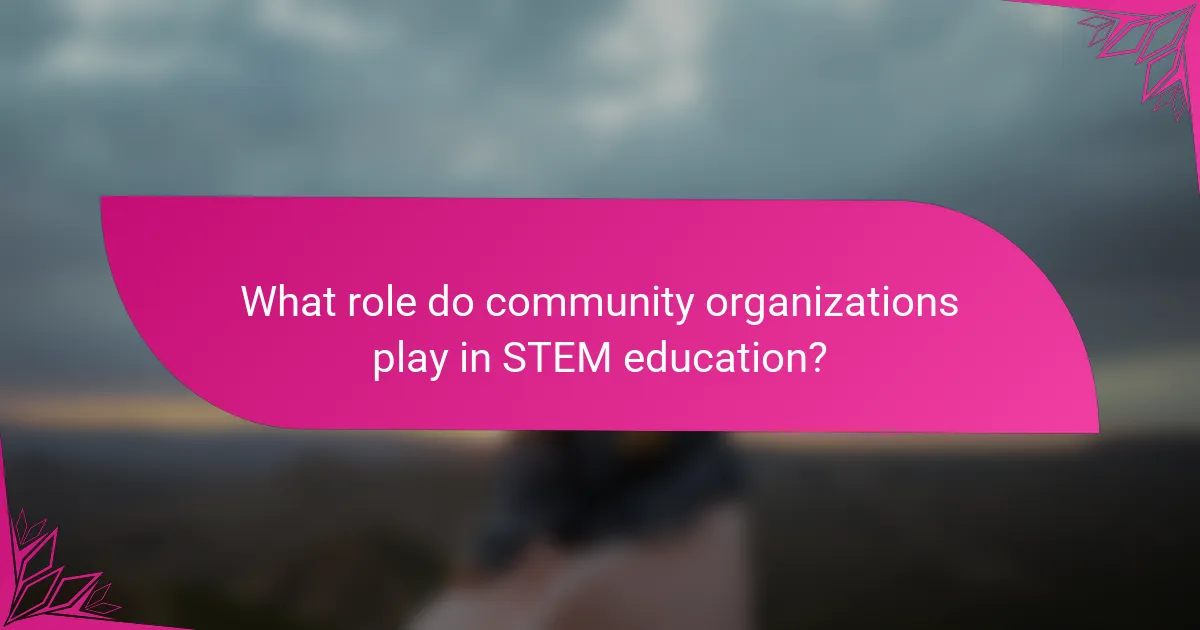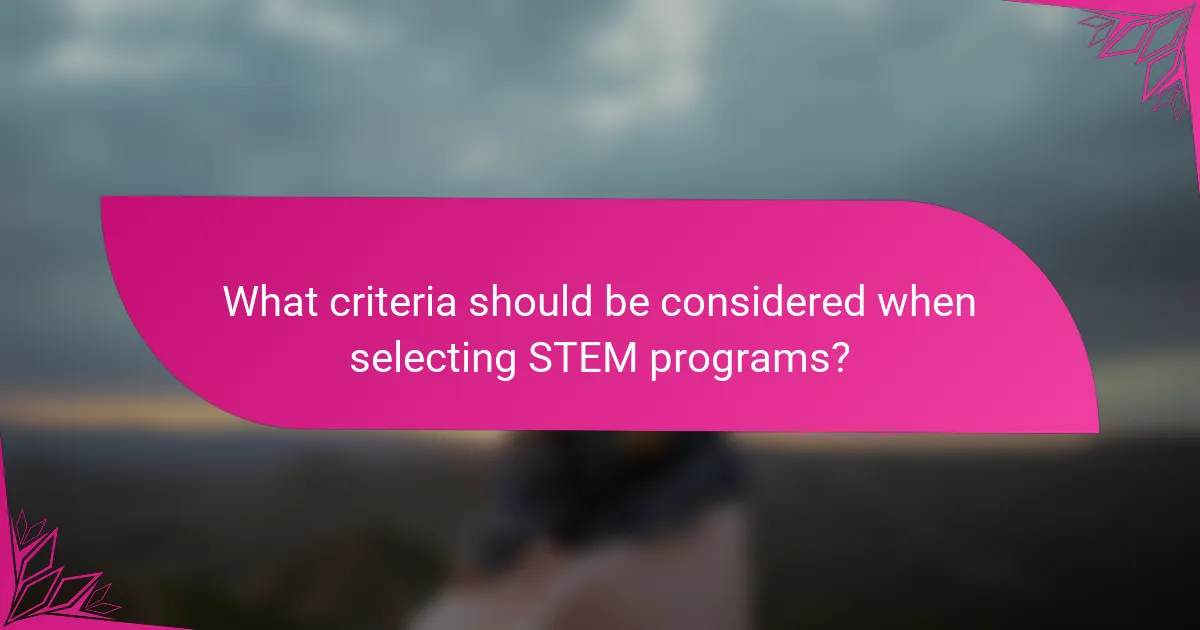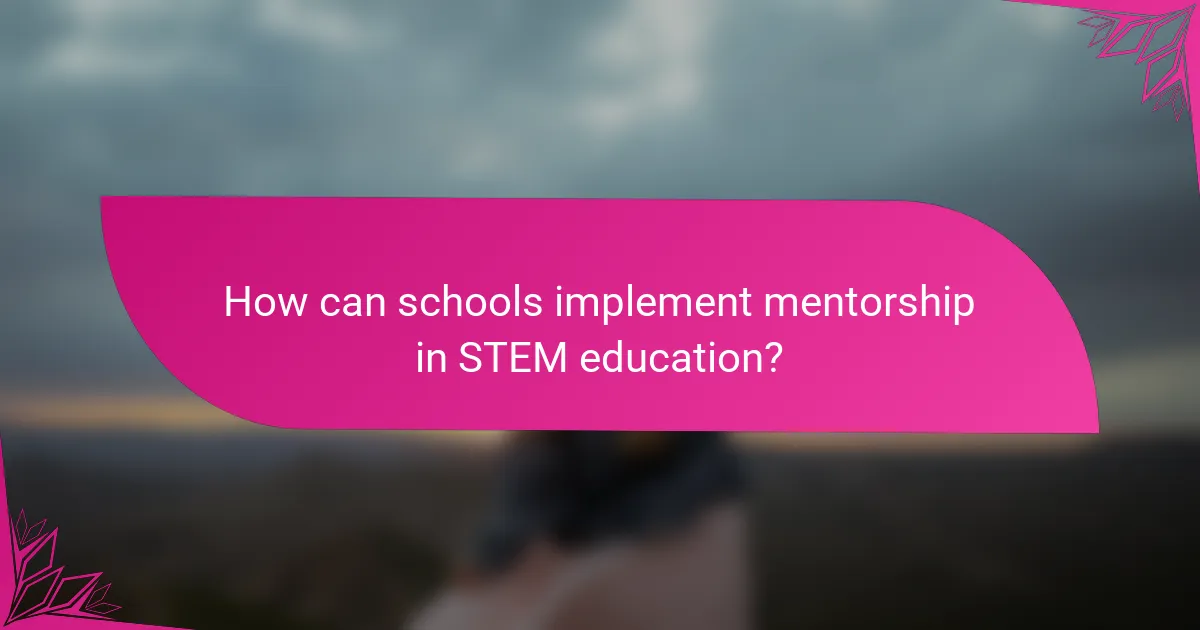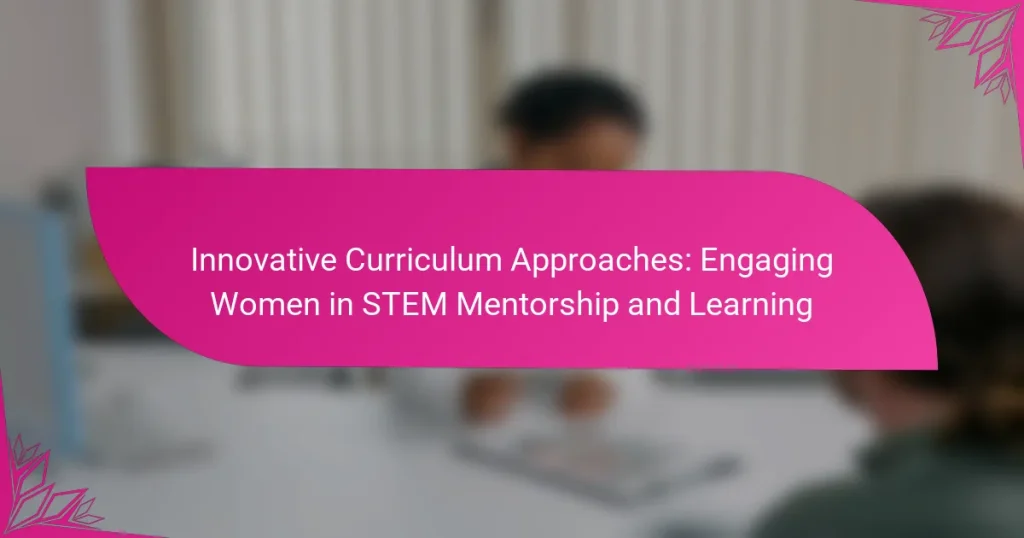Innovative curriculum approaches are essential for engaging women in STEM, as they emphasize interactive and collaborative learning that aligns with students’ interests and career goals. By integrating effective mentorship models and leveraging technology tools, these strategies not only enhance learning experiences but also contribute to closing the gender gap in STEM fields.

How can innovative curricula engage women in STEM in the United States?
Innovative curricula can engage women in STEM by incorporating interactive and collaborative learning experiences that resonate with their interests and career aspirations. By focusing on practical applications and mentorship, these approaches can help bridge the gender gap in STEM fields.
Project-based learning initiatives
Project-based learning (PBL) initiatives immerse students in real-world challenges, allowing them to apply STEM concepts in practical settings. These projects often involve teamwork and problem-solving, which can enhance engagement and retention among women in STEM.
For instance, a PBL initiative might involve developing a sustainable energy solution for a local community. This hands-on experience not only builds technical skills but also fosters a sense of accomplishment and relevance.
Collaborative mentorship programs
Collaborative mentorship programs connect women with experienced professionals in STEM fields, providing guidance and support. These programs often pair mentees with mentors who share similar backgrounds or interests, creating a more relatable and impactful experience.
Successful programs may include regular meetings, networking events, and workshops that focus on both technical skills and career development. Establishing a strong mentor-mentee relationship can significantly boost confidence and encourage persistence in STEM careers.
Hands-on workshops with industry leaders
Hands-on workshops led by industry leaders offer women practical exposure to current technologies and practices in STEM. These workshops typically emphasize skill-building through direct interaction with tools and methodologies used in the field.
For example, a workshop on coding might involve participants working on real software projects, guided by professionals from tech companies. Such experiences not only enhance technical abilities but also help women build valuable industry connections.

What are effective mentorship models for women in STEM?
Effective mentorship models for women in STEM include structured peer networks, alumni connections, and corporate sponsorships. Each model provides unique benefits, fostering professional growth and increasing retention rates among women in these fields.
Peer mentorship networks
Peer mentorship networks involve groups of women at similar career stages who support each other through shared experiences and challenges. These networks can be informal or organized through institutions and often focus on skill development, networking, and emotional support.
To establish a successful peer mentorship network, consider creating regular meetups or online forums. Encourage members to share resources, discuss industry trends, and provide feedback on each other’s work. This collaborative environment can enhance confidence and foster a sense of belonging.
Alumni mentorship connections
Alumni mentorship connections leverage the experiences of former students to guide current learners in STEM fields. Alumni can offer insights into career paths, industry expectations, and networking opportunities, making them valuable resources for mentees.
To facilitate these connections, institutions can organize alumni panels, networking events, or one-on-one mentorship programs. Encourage alumni to share their career journeys and provide practical advice, which can inspire and motivate current students to pursue their goals.
Corporate sponsorship mentorship
Corporate sponsorship mentorship involves partnerships between companies and women in STEM, providing access to resources, training, and professional development. This model often includes mentorship from experienced professionals within the organization, enhancing career advancement opportunities.
When implementing corporate sponsorship, companies should focus on creating structured programs that pair employees with mentors who align with their career aspirations. Offering workshops, internships, and networking events can further enrich the mentorship experience and help women build valuable connections in their fields.

How do technology tools enhance STEM learning for women?
Technology tools significantly enhance STEM learning for women by providing flexible access to resources, fostering collaboration, and creating immersive learning experiences. These tools cater to diverse learning styles and help bridge the gender gap in STEM fields.
Online learning platforms like Coursera
Online learning platforms, such as Coursera, offer a wide range of STEM courses tailored for women. These platforms provide flexibility, allowing learners to study at their own pace and access high-quality content from renowned institutions worldwide.
Women can benefit from courses that focus on practical skills, such as data analysis or programming, which are crucial in today’s job market. Additionally, many platforms offer financial aid options, making education more accessible.
Virtual reality simulations
Virtual reality (VR) simulations create engaging, immersive environments that enhance STEM learning for women. These simulations allow learners to explore complex concepts in a hands-on manner, making abstract ideas more tangible.
For instance, VR can simulate scientific experiments or engineering challenges, enabling women to practice skills in a risk-free setting. This experiential learning approach can boost confidence and interest in STEM subjects.
Interactive coding environments
Interactive coding environments, like Codecademy or Replit, provide women with practical coding experience through hands-on exercises. These platforms allow learners to write and test code in real-time, reinforcing concepts through immediate feedback.
Such environments often include community features, where women can collaborate, share projects, and seek help, fostering a supportive learning atmosphere. This peer interaction can be particularly motivating and beneficial for women entering the tech field.

What role do community organizations play in STEM education?
Community organizations are vital in STEM education by providing resources, mentorship, and networking opportunities that engage women in these fields. They help bridge the gap between formal education and real-world applications, fostering an inclusive environment for learning and growth.
Local STEM outreach programs
Local STEM outreach programs are designed to connect students with hands-on experiences in science, technology, engineering, and mathematics. These initiatives often include workshops, demonstrations, and field trips that make STEM subjects more accessible and relatable.
For instance, programs may partner with schools to offer after-school activities or summer camps that focus on coding, robotics, or environmental science. Engaging local professionals as mentors can enhance these programs, providing students with insights into potential career paths.
Partnerships with universities
Partnerships between community organizations and universities create pathways for women to pursue STEM education. These collaborations often result in scholarship opportunities, internships, and research projects that allow participants to gain valuable experience in academic settings.
Such partnerships can also facilitate mentorship programs where university students or faculty guide younger women, helping them navigate their educational journeys. This support can significantly increase retention rates in STEM fields.
Workshops hosted by non-profits
Workshops hosted by non-profit organizations focus on skill development and knowledge sharing in STEM disciplines. These workshops often cover topics like programming, data analysis, and engineering principles, tailored specifically for women and underrepresented groups.
Non-profits may offer these workshops at low or no cost, making them accessible to a wider audience. Participants can benefit from hands-on learning experiences, networking opportunities, and resources that empower them to pursue further education or careers in STEM.

What criteria should be considered when selecting STEM programs?
When selecting STEM programs, it is essential to consider criteria such as curriculum alignment with industry standards, accessibility and inclusivity measures, and feedback from participants. These factors ensure that programs are relevant, equitable, and effective in engaging women in STEM fields.
Curriculum alignment with industry standards
Curriculum alignment with industry standards ensures that the content taught in STEM programs meets the current demands of the job market. This includes integrating skills and knowledge that employers seek, such as coding languages, data analysis, and project management methodologies.
To evaluate alignment, review the program’s partnerships with local businesses and industry leaders. Programs that offer internships or collaborative projects with companies often provide students with practical experience that enhances their employability.
Accessibility and inclusivity measures
Accessibility and inclusivity measures are crucial for creating an environment where all women can thrive in STEM education. This includes providing resources such as scholarships, flexible schedules, and support services for those with disabilities or other barriers to participation.
Programs should also promote a diverse learning atmosphere by incorporating diverse role models and mentors. This can help foster a sense of belonging and encourage women from various backgrounds to engage with STEM subjects.
Feedback from participants
Gathering feedback from participants is vital for assessing the effectiveness of STEM programs. Surveys and focus groups can provide insights into what aspects of the program worked well and what areas need improvement.
Consider implementing a regular feedback loop where participants can voice their experiences and suggestions. This not only helps in refining the curriculum but also empowers women by valuing their input in shaping the program.

How can schools implement mentorship in STEM education?
Schools can implement mentorship in STEM education by establishing structured programs that connect students with experienced professionals or educators. These programs should focus on fostering relationships that encourage girls to pursue STEM fields through guidance, support, and practical learning experiences.
Integrating mentorship into the curriculum
Integrating mentorship into the curriculum involves embedding mentorship opportunities within existing STEM courses. Schools can design projects that require collaboration with mentors, allowing students to apply theoretical knowledge in real-world contexts.
For example, a school might partner with local tech companies to provide students with hands-on projects, where mentors guide them through problem-solving processes. This not only enhances learning but also builds confidence in students, particularly girls, who may feel intimidated in traditionally male-dominated fields.
Training teachers as mentors
Training teachers as mentors is crucial for creating a supportive environment in STEM education. Professional development programs should focus on equipping teachers with mentorship skills, such as active listening, providing constructive feedback, and fostering a growth mindset.
Schools can facilitate workshops that emphasize the importance of mentorship and provide teachers with tools to effectively guide students. This investment in teacher training ensures that educators are not just instructors but also supportive mentors who can inspire and motivate their students.
Creating mentorship matching systems
Creating mentorship matching systems involves developing a structured approach to pair students with suitable mentors based on interests and career goals. Schools can use surveys to assess student preferences and mentor expertise, ensuring meaningful connections.
For instance, a simple online platform could facilitate this matching process, allowing students to browse mentor profiles and select individuals they resonate with. Regular feedback and adjustments to the matching process can enhance the effectiveness of these mentorship relationships over time.


